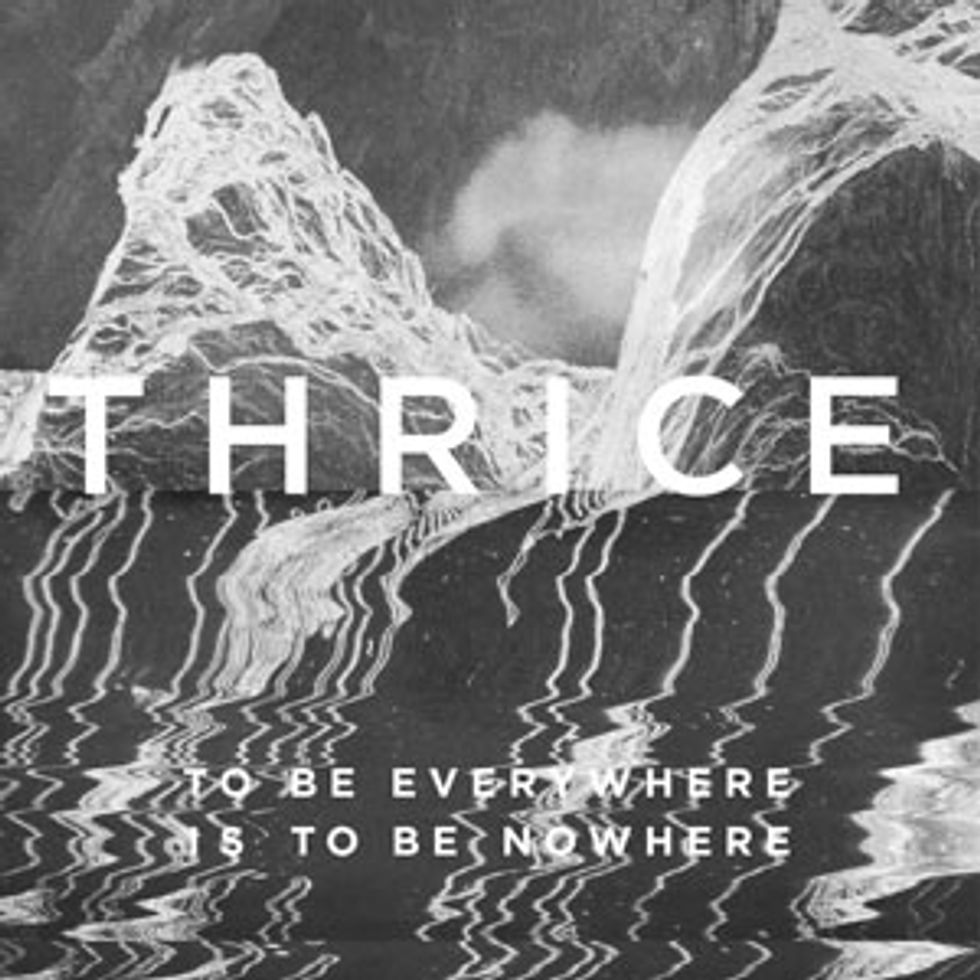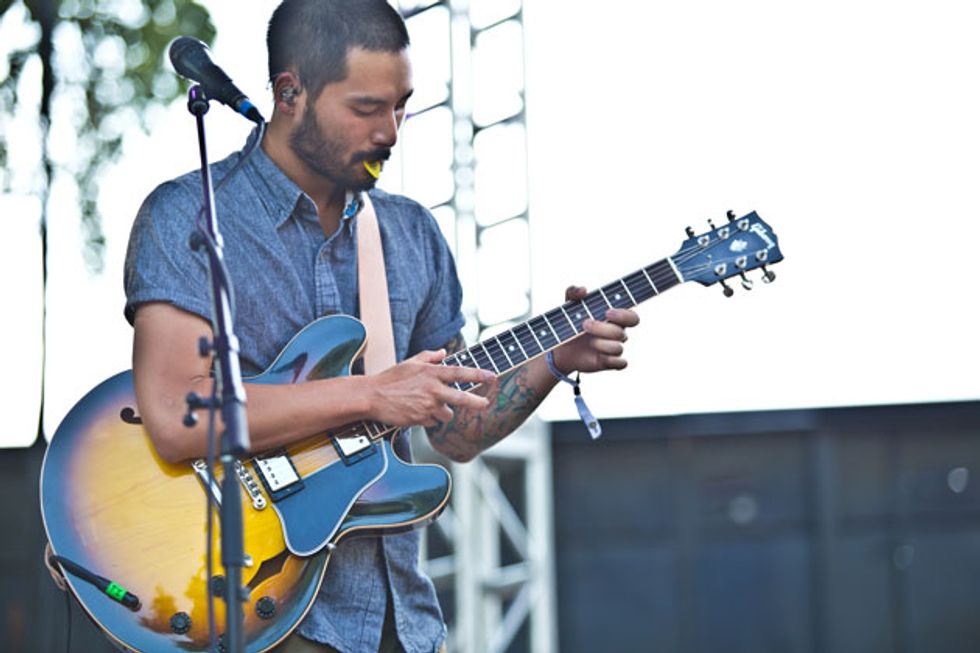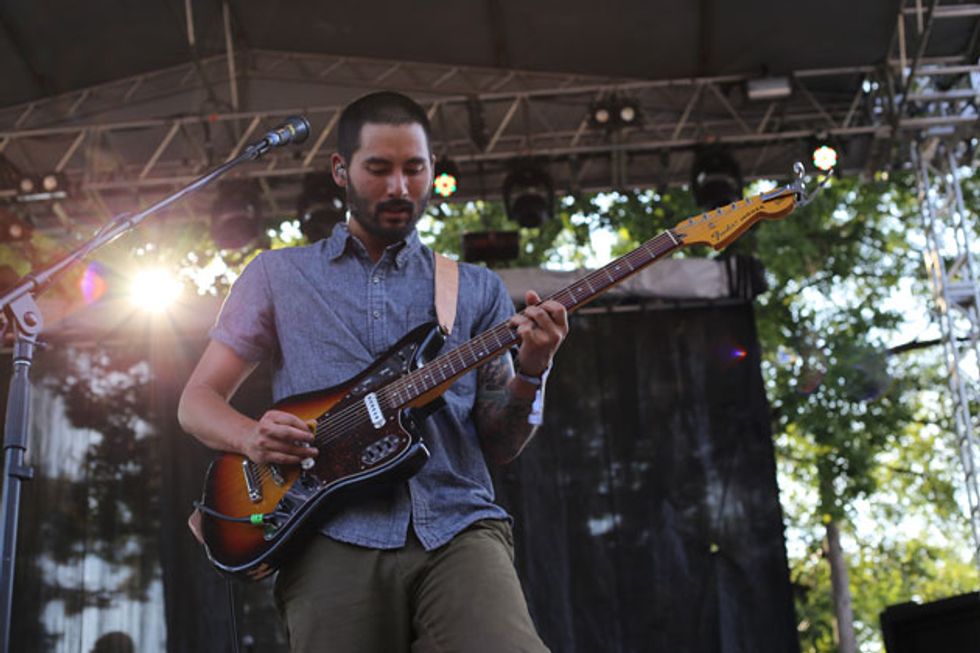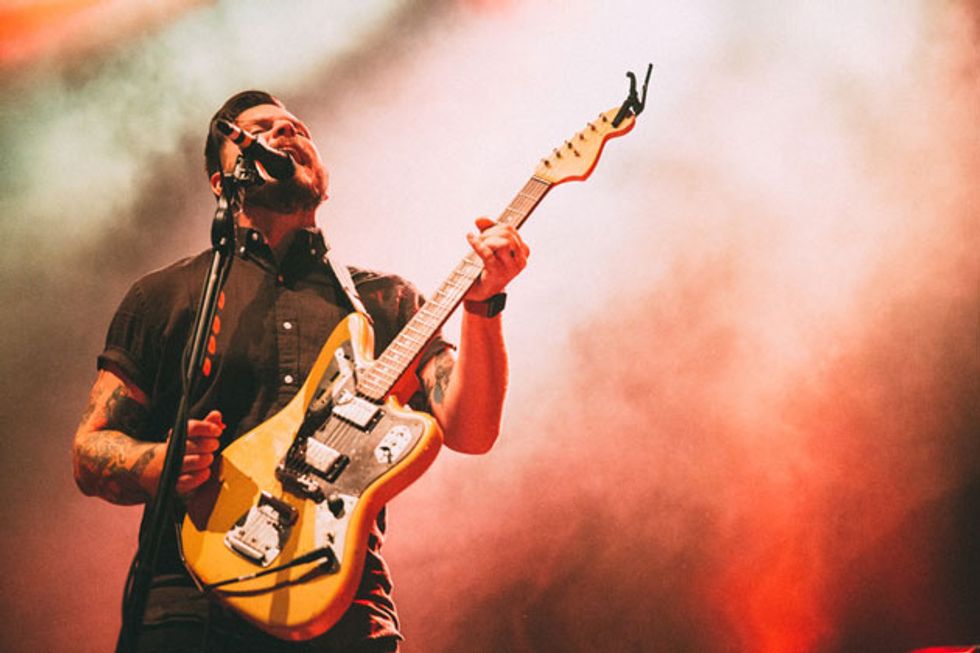Never content to stand still, Thrice is a band that defies easy categorization. Formed in 1998 in Irvine, California, by Dustin Kensrue and Teppei Teranishi, the band began playing an amalgam of punk, metal, and hardcore. “I remember trying to get shows around here in Orange County in 1999 or 2000,” recalls Teranishi. “People were like, ‘Well, you’re not really a punk band, but you’re not really a hardcore band. We don’t know what kind of shows to place you on.”
Thrice’s musical evolution continued in 2005 with the release of Vheissu, which featured a broader variety of instrumentation—including piano, strings, some electronic programming, and even a song inspired by a music box—than the band had previously explored. This set the stage for the critically acclaimed 2007 concept album, The Alchemy Index, which debuted at No. 24 on the Billboard 200 chart and reached No. 5 on iTunes’ list of top-selling albums. The Alchemy Index was born as a series of four EPs, each of which was sonically inspired by a different element in nature: fire, water, air, and earth.
“I think The Alchemy Index was a really interesting and cool experience, in the sense of being able to do something totally outside our box,” Teranishi offers. “And that, I think, was the result of having boundaries. That was the first and only time really that we’ve written with a specific target in mind. We kind of made these boundaries like, “All right, the water EP—it’s going to be electronic. It’s going to have these kinds of sounds. The tones are going to sound like this or that. We were actually writing with some specific goals, whereas everything else we were just kind of writing whatever.”
After releasing Vheissu and The Alchemy Index, both of which the band has described as having a “sleepy feeling,” Thrice set out to make a more upbeat, lively record. In 2009 Beggars was released, followed by Major/Minor in 2011, both of which further bolstered Thrice as a titanic name in indie rock. But after touring in support of Major/Minor in 2012, Thrice announced an indefinite hiatus so its members could focus on personal projects.
Fans rejoiced in December 2014 when a somewhat cryptic image of the band in the studio surfaced on their website with large text that simply read “Thrice 2015.” Within two months they announced some festival dates, followed a year later by the announcement of their new album, To Be Everywhere Is to Be Nowhere.
To achieve new levels of drone tone on their ninth studio album, Teranishi and Kensrue experimented with custom string gauges, dropped and offbeat tunings on their baritone guitars, and added choice chorus and overdrives to their sonic palette. The result is a tastefully written and produced album that should leave the Thrice faithful feeling nothing less than satisfied. To Be Everywhere Is to Be Nowhere has the group’s unmistakable signature elements: catchy melodies, nuanced songwriting, and parts designed to illicit an emotional reaction from the listener.
We recently caught up with Kensrue and Teranishi to discuss the sonic evolution of Thrice, the new album (which Kensrue considers their most melodic release to date), and how members of the band Brand New inspired Thrice’s return from a nearly four-year hiatus.

To Be Everywhere Is to Be Nowhere is Thrice's ninth studio album and released May 27, 2016, on Vagrant Records. Click here to stream the whole album.
What were you doing during the break?
Teranishi: We were all doing different things. Dustin was up in Seattle working with a church, I was in nearby Vashon Island where I started a leather/canvas goods design and craft studio. I was really keeping myself busy with work, but I was still making art by working with my hands and leather, so the creativity itch was being scratched. I did have thoughts of maybe dabbling in production or engineering, but I’d been doing music for my entire adult life, and it gets to a point where you just need a break. I took it as an opportunity to explore new things, so it wasn’t like me sitting around thinking,“Man, I gotta get back on the road.”
So what was the catalyst for the return of Thrice?
Teranishi: I guess it was when Dustin and I went out to a Brand New show—they were doing something like a short, two-week West Coast run—and it gave us a fresh perspective on touring and being in a band without being gone all the time. That experience allowed us to consider that we could go back on the road and be Thrice without sacrificing all of our time or home lives.
Why did you start playing guitar, and what still turns you on about it over the years?
Teranishi: My dad played guitar, so there was always one around the house, plus both my parents were really into music. And I think it was just kind of natural for me to want to pick it up. Probably around 5th or 6th grade I started really getting into Metallica and that’s what made me start playing guitar.
What was your first guitar?
Teranishi: It was one my dad got me—I don’t even know what brand it was—it was a half-size electric guitar. My first real guitar was a Fender Prodigy. It’s a super low-end model that I probably got at Guitar Center, but it had a Strat-style body, a humbucker in the bridge, and single-coils in the middle and neck positions.
What do you think makes for exciting guitar playing? Is it passion, technical skill, creativity, or a mixture?
Kensrue: For me, exciting guitar playing is stuff that feels good—not stuff that’s super technical. I’ve never been into really technical guitar playing because I personally think real technical players can come off as generic. Lots of guys can shred my face off, but to me it seems like you need something more, like passion and creativity. I never thought of myself as much of a guitar player until maybe halfway through our career. I was a singer that was just trying to keep up with Teppei on guitar. On Beggars I started becoming more interested in playing guitar and began to feel like I understood my own style of playing more. I think now I can play with feeling and come up with some interesting stuff. For instance, on this record I’m playing more leads—like on “Hurricane,” or the super messy solo in “The Window.” I’ve always really loved playing. None of it is really technical or difficult, but I’ve had a lot of fun dialing in my tone this time.
Teranishi focuses hard on his ES-335 during a performance at Atlanta’s Wrecking Ball festival in August 2015. “When we first started,” he says, “we were all listening to metal, punk rock, and hardcore. It was just natural for us to melt
all those things together.” Photo by Perry Bean
Did you set out to become a genre-bending band, or is that something that happened naturally?
Teranishi: No, I think it’s definitely natural. When we first started, our musical tastes were a lot narrower, but we were all listening to metal, punk rock, and hardcore. I think it was just natural for us to want to kind of melt all those things together.
Kensrue: It definitely evolved over time, but I think way back in the day we thought there was something interesting about trying to mix some punk rock and little bits of metal guitar tied together with a hardcore sensibility. It was just a mix of bands we dug at the time, really. We were listening to a lot of new school, West Coast punk. We were listening to East Coast stuff like Minor Threat. And, of course, we were listening to Iron Maiden and bands like that. When you’re creating, you learn by taking different pieces and comping them and putting them into a new context. At a certain point that becomes unconscious—you don’t even think about it anymore.
After releasing so much material over the years, how do you avoid slipping into familiar patterns?
Teranishi: I think it’s getting harder as our catalog grows. We’re aware of it, but at the same time, I believe you don’t ever want to force creativity. I feel like your first or most natural instinct is probably the best. But, yeah, it is hard. It would be interesting to do something themed like The Alchemy Index again for that reason—it might draw something new and different out of us.
Teppei Teranishi’s Gear
Guitars’72 Les Paul Standard
Nash T-Model
Fender Jaguar Baritone Custom (renamed Jaguar Bass VI Custom in 2006)
Amps
Vox AC30
Effects
Walrus Aetos Power Supply
Walrus Descent
JHS Panther Cub
Walrus Julia
JHS Pulp ’N’ Peel
JHS Double Barrel
Walrus switcher
Mojo Hand FX Bayou Tremolo
Mission Engineering expression pedal
Line 6 M5 Stompbox Modeler
Dustin Kensrue’s Gear
GuitarsNash JM-63 with Lollar High Wind Imperial Humbucker (bridge) and Lollar El Rayo Humbucker (neck)
Cave and Canary Baritone Solaris
Fender Jaguar Baritone Custom
Amps
Fender ’68 Custom Vibrolux
New Vintage Amps Custom “DK36” (MK36 modded by Nic Patullo from New Vintage)
Effects
Strymon BigSky Reverberator
Strymon Mobius Multidimensional Modulation
Strymon TimeLine Delay
Electro-Harmonix POG2
Walrus Iron Horse Distortion
Walrus Deep Six Compressor
Walrus Harvester Overdrive
Mojo Hand FX “Kensrue” Rook Overdrive
JHS Muffuletta
JHS Mini Foot Fuzz
Line 6 M5 Stompbox Modeler
TC Electronic PolyTune Mini
Voodoo Lab HEX Loop Switcher (2)
FAMC Liquid Foot+ Mini MIDI controller
As your sound has evolved, it stands to reason that your taste in gear has as well. Is there any gear in your collection that’s inspired more riffs than others? Or changed the way you play or even write?
Teranishi: The baritone has for sure. Mine is a 2005 or 2006 Jaguar Bass VI Custom. It’s not the current one that has humbuckers. Mine has a slightly longer scale and shrill, thin, brittle, single-coils. I think that sounds cool in that lower tuning. I love that contrast between something that’s harsh and thin, yet heavy and low. That sound has inspired a lot of stuff like “Yellow Belly,” the first song on Major/Minor.
Kensrue: Teppei has a Casino that I love, and he loves it, too. It’s a hollowbody, so it sings quite a bit. Even unplugged it’s really fun to play. In the studio it would inspire me a lot … maybe I should get one.
In your opinion, what constitutes “heavy?”
Teranishi: I think it’s a combination of a few things. Tuning plays a big part, because you can take something that doesn’t sound that heavy on a regular guitar in E standard, and then play it on a baritone in B standard and suddenly it sounds really heavy. Also the groove. To me, those are the biggest things. The arrangement can play a big role, as well, because a dynamic contrast of sounds can make things heavy.
Speaking of tuning, Dustin, I hear you’re pretty picky about your gauges?
Kensrue: I’m specific about it because the way a guitar feels to me is pretty important. I think string gauge has a lot to do with that. The reason it’s more complicated for us is we’re typically tuning down to D standard or dropped C, and that lessens the tension. I’m also playing a 24"-scale guitar, which lowers the tension even more. I had to figure out how to balance all of that and make it feel right. I keep it just tight enough for me to play some chunky stuff if I need to, but it’s also fun and loose.
For that [28.5"-scale] Jag, I’m using a custom set of .011, .014, .018, .032, .044, .056. We had a bunch of old strings that weren’t part of full sets, so I experimented until I landed on that combination. Teppei is not as picky, so he just uses whatever gauge I’m using.
How democratic is your songwriting process?
Teranishi: It’s actually a pretty democratic process. We all bring stuff to the table. Even Riley [Breckenridge, drummer] will bring guitar parts sometimes. That also makes it challenging because you don’t have one person calling all the shots and everything can be a big, drawn-out discussion. But that’s a part of what makes us Thrice.
And do you build the songs around vocal melodies or chord progressions?
Teranishi: On this record, we wrote around melodies a lot more than we have in the past, and I think that shows. I feel like it's a more melodic record in a lot of senses. There was a lot of this: “I got this cool melody, but it’s not working with this chord.” Then Dustin would try to tweak the chord progression to fit it around the melody, which we have done in the past, but I think we did a lot more of that this time around.
Kensrue: We often begin with some kind of riff and then I just start singing nonsense over it until I find something I like. Melodies come pretty quickly—it’s the lyrics that take a long time.
When recording this album, what were your main guitars?
Teranishi: I used my Gibson ES-335 a little bit, a Tele, and obviously the baritones. The one that I revisited for this record was an early-’70s cherry red Les Paul Standard that I’ve had forever. I actually used it a lot on the earlier records—I think it was almost exclusively on The Illusion of Safety and it probably saw some action on The Artist in the Ambulance. I hadn’t played it in a long time, but I broke it out and used it on quite a few tracks.
Thrice’s main riff-writer Teppei Teranishi plays a Fender Jaguar Baritone Custom during the band’s set at the 2015 Wrecking Ball festival in Atlanta, Georgia. Photo by Perry Bean
Is your touring rig pretty close to what you recorded with?
Teranishi: Yeah. In the past, like with Major/Minor, we wanted to track live, so that was as straightforward as possible. But this record was a lot different because our producer, Eric Palmquist, was intentional about trying to pull some different tones out of us. He set up maybe four or five different amps at the same time and he’d mix and match in the control room to get the kind of tones that he wanted.
He relied heavily on a ’66 Fender Bassman that was pretty much running all the time, and he was also running a Marshall JCM800. He had some other amps that I didn’t even really look at, but the one that really stuck out to me was this little Watkins Scout. It’s this tiny, old amp that I think was maybe 10 watts. It had a sweet, creamy, nice and compressed distortion that I thought sounded really cool. For the clean tones, we used a lot of the Roland Jazz Chorus combo. We would start recording, and then Eric would say, “Play the part,” and he’d go out into the live room and tweak the amps. And then he’d come back into the control room and we would listen to it and make changes, if needed, based on what we all heard.
What was your pedal setup like for this record?
Teranishi: Well, I just changed up my whole pedal scenario. On this last record, I didn’t just walk in with my pedalboard and set up for recording. Instead, we had a mountain of pedals sitting in the control room, and Eric was really into fiddling with them. However, most of the distortion came from running my AC30 really hot—I’m a fan of tube distortion. I did subtly use my JHS Pulp ’N’ Peel compressor in front of the AC30. I also used a JHS overdrive for stuff that I wanted to boost, and for most of the cleaner parts, I just rolled back the volume.
Kensrue: For a long time, I was getting all of my gain by driving my amp really hard, and then backing it off for clean tones, but I could never quite clean it up as much as I wanted. Then I realized you could have the best of both worlds by using overdrives to push the tubes. So now I’m basically using two amps that are just on the edge of breaking with stacked overdrives so the amps feel and sound really lively. I’m actually trying these Mojo Hand FX Rook Overdrives to get my baseline sound. They constitute my middle tone, and then I’m boosting up or dropping down from there. Mojo Hand is actually doing a small run of custom artwork Rooks for me that should be available soon. Those Rooks work really well for running into other pedals and I have one going into the Walrus Audio Harvester for the next step of gain. And I didn’t think I was going to land here, but my last pedal in that chain is a Walrus Audio Iron Horse distortion as the last piece on my amp plate. I keep it set with the distortion knob almost off because it’s got a really nice, tight low end that I haven’t had in a long time. So, the tonal characteristics are not really shifting, the Iron Horse is just firming things up and giving it a little extra punch.
Right now I’m looking at it like this: I want to have five levels of sounds. I consider my Rook as about three or in the middle, and if I want to come down from there, I subtract volume going into it. If I want to go up, I add the Harvester and then, I add the Iron Horse on top of that. I have a pretty complicated board that runs with a MIDI controller, and one of the pedals on my board that I use like a Swiss Army Knife is a Line 6M5. It has the ability to create volume presets that I have set to 75 percent, 55 percent, and a 35 percent setting of my total input volume. And so, I'll just cut the input into the drive pedals because I feel like rolling off the guitar’s volume knob muddies the tone.
Thrice’s cofounding guitarist/frontman Dustin Kensrue wields his Nash JM-63, which has Lollar humbuckers—a High Wind Imperial at the bridge and El Rayo in the neck position. Photo by Sangsouvanh Ping Khounivichit
Teppei uses a M5 live because there are a couple of random parts that would otherwise require a bunch of different pedals. The M5 streamlines this for both of us. I’m using the Liquid Foot controller—it’s a really cool system—because I’m singing and playing. Using MIDI means I don’t have to dance around the board. I’ve been using it for the past year now and I feel like I’ve finally got the hang of it. I’m thinking of redesigning my setup right now to simplify things even more.
Were there any wacky effects that you never thought you would see yourself using that appeared on this record?
Teranishi: Yeah, definitely. There was a lot of chorus on this record, which we never used before. It came from the Roland Jazz Chorus. Eric had a bunch of really weird pedals, and a lot of them I wasn’t familiar with. Dustin has an Electro-Harmonix POG that we actually used a lot, too. It’s cool because you can use it pretty subtly. For example, if you want a little something more on a lead, you just sneak in a little bit of the higher octave and it sounds great. I’ve never really used one of those before, and I thought it was a cool pedal.
Kensrue: The Walrus Audio Julia is a newer chorus/vibrato pedal that sounds killer and has lots of different sounds that are all really usable. Instead of just turning either chorus or vibrato on, it has a blend control. It’s kind of shocking how many sounds you can get out of it.
YouTube It
Thrice jams “Black Honey,” the second single from To Be Everywhere Is to Be Nowhere, live at the Fillmore in Silver Spring, Maryland. Be sure to check out Teppei’s droney, baritone lead in the intro that sets the mood for the entire song.
Songs like “Death from Above,” “Whistleblower,” and “Blood on the Sand” are very politically charged. Given the current state of affairs, do you think music can shift the political zeitgeist?
Kensrue: I believe everything can change. The way in which people react to music is unique. It has a lot of potential to change us on an individual level, and it’s individuals who are going to change society.















![Rig Rundown: Russian Circles’ Mike Sullivan [2025]](https://www.premierguitar.com/media-library/youtube.jpg?id=62303631&width=1245&height=700&quality=70&coordinates=0%2C0%2C0%2C0)












![Rig Rundown: AFI [2025]](https://www.premierguitar.com/media-library/youtube.jpg?id=62064741&width=1245&height=700&quality=70&coordinates=0%2C0%2C0%2C0)




















 Zach loves his Sovtek Mig 60 head, which he plays through a cab he built himself at a pipe-organ shop in Denver. Every glue joint is lined with thin leather for maximum air tightness, and it’s stocked with Celestion G12M Greenback speakers.
Zach loves his Sovtek Mig 60 head, which he plays through a cab he built himself at a pipe-organ shop in Denver. Every glue joint is lined with thin leather for maximum air tightness, and it’s stocked with Celestion G12M Greenback speakers.











